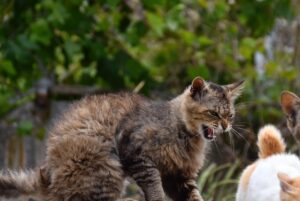Human bullying has become a social issue, but is there bullying in the world of cats?
If there is bullying, what are the causes and how can it be resolved?
Here, as someone with experience in raising multiple cats, I will introduce the reality of cat bullying and how to deal with it.
Table of Contents
1. What is cat bullying?
∟1-1. Cats bullying others
∟1-2. Cats being bullied
2. Acts considered as bullying
∟2-1. Stealing food
∟2-2. Intimidation
∟2-3. Pouncing
∟2-4. Chasing
∟2-5. Exclusion
3. Dealing with cat bullying
∟3-1. Isolation
∟3-2. Neutering/Spaying
∟3-3. Relieving stress
∟3-4. Finding a new owner
4. Raising multiple cats with bullying in mind
Conclusion
1. What is cat bullying?

We often come across scenes of cats fighting with each other, but witnessing one cat bullying another is not so common.
However, bullying does occur in the world of cats.
Common cases of cat-on-cat bullying include bullying in the community of outdoor cats or situations where indoor cats, kept in multiples, are bullied by their housemates.
In the world of cats as well, it is natural for the stronger ones to bully the weaker ones.
Observing cases of bullying, it is often seen that one or a group of cats bullies a weaker cat.
1-1. Cats bullying others
When looking at the relationships between cats kept in multiples, it is common to see cases where the resident cat bullies the newcomer.
Also, larger cats tend to bully smaller cats more frequently.
Comparing male and female cats, it is a fact that male cats overwhelmingly bully female cats.
1-2. Cats being bullied
The usual targets of bullying are cats that are timid, always nervous, and find it difficult to adapt to communal living.
Moreover, it is said that the majority of those being bullied are female cats.
Weaker and timid cats, especially females, become targets of bullying.
Cats with illnesses or those exhibiting spraying behavior also tend to be targets of bullying.
2. Acts considered as bullying

It has been mentioned that stronger cats target weaker ones, but how do these actions manifest?
2-1. Stealing food
Due to their strong appetite, stronger cats often steal food from weaker cats, which can be considered a form of bullying.
The weaker cat cannot show a strong attitude in response.
As this becomes a routine, the stronger cat learns that it is acceptable to eat the weaker cat's portion during every meal, leading to the first step of bullying.
2-2. Intimidation
Cats intimidating each other is a common sight during fights.
However, this behavior is also frequently observed during instances of bullying.
The stronger cat intimidates the weaker cat, likely underestimating the opponent's strength.
This behavior is often seen when the stronger cat tries to drive away the weaker cat, who leaves the scene without resistance, making it appear like bullying.
2-3. Pouncing
Cats, being natural hunters, attempt to pounce and overpower weaker animals to satisfy their hunting instincts.
In a multi-cat household, it is common for a stronger cat to suddenly pounce on a weaker cat, knocking it down.
This is another form of bullying.
2-4. Chasing
Chasing is one of the most common forms of bullying among cats.
The stronger cat chases the weaker one around the house or yard, causing stress to the weaker cat.
If the stronger cat corners the weaker one, it might result in a physical confrontation.
2-5. Exclusion
Exclusion is a form of psychological bullying.
The stronger cat actively ignores or avoids the weaker cat, making it feel isolated and lonely.
Isolation can lead to stress and various health problems for the excluded cat.
3. Dealing with cat bullying
How should we deal with cat bullying? Here are some effective countermeasures:
3-1. Isolation
If a cat is being bullied, consider isolating the bullied cat from the rest of the group temporarily.
Isolation provides a safe space for the bullied cat to recover without the fear of being attacked.
Make sure to provide the isolated cat with all the necessary amenities.
3-2. Neutering/Spaying
Neutering or spaying your cats can help reduce aggressive behaviors, including bullying.
It is advisable to neuter or spay your cats at an appropriate age to prevent the development of bullying tendencies.
3-3. Relieving stress
Identify and address the sources of stress in your cat's environment.
Provide hiding spots, scratching posts, and interactive toys to keep your cats mentally and physically stimulated.
3-4. Finding a new owner
If cat bullying persists despite efforts to intervene, finding a new home for one of the cats may be a last resort.
Rehoming a cat to a suitable environment where it can thrive without being bullied is a responsible decision.
4. Raising multiple cats with bullying in mind
If you are considering raising multiple cats, it is crucial to be aware of the potential for bullying and take preventive measures.
When introducing a new cat to the household, do so gradually and monitor their interactions closely.
Provide enough resources, such as food bowls, litter boxes, and resting spots, to minimize competition among cats.
Conclusion
Living with multiple cats can be a rewarding experience, but it comes with its challenges, including the possibility of bullying.
Understanding the signs of bullying and taking proactive measures can create a harmonious and stress-free environment for your feline companions.
By being a responsible cat owner, you contribute to the well-being and happiness of your cats.



